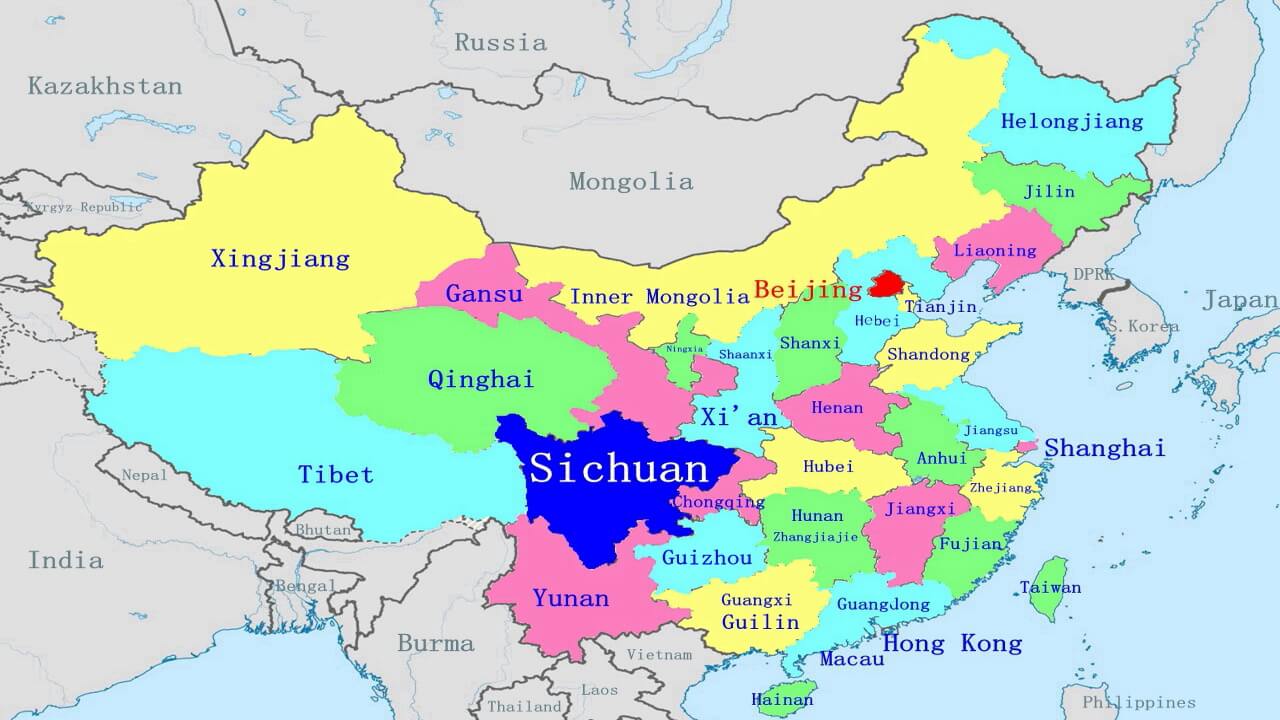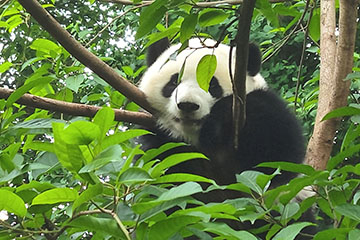Name in Chinese: 四川 Sì Chuān [si tsuæ]
Location: Southwest part of China, GMT+8
Population: 85 million
Reputations: the Home Town of Giant Pandas, the Land of Abundance, the Paradise of Delicious Food, the Birthplace of Taoism, the Incubator of Chinese Tea Culture and Silk Culture, the Crown of China’s Tourism
Overview:
Sichuan province is located in the hinterland of southwest China. It is the main habitat of the lovely giant pandas. Chuan and Shu are the abbreviations for Sichuan. The entire province is 1,075 kilometers(668 miles) from east to west, and 927 kilometers(576 miles) from north to south. With the third largest population in China, it covers an area of 486,000 square kilometers(187,645 sq.mi). Sichuan is situated in the magical 30 degrees north latitude, the same latitude of Pyramids of Egypt, the Mayan Ruins and Ancient Babylonian Ruins. Its topography is complex and diverse. It embraces Qinghai-Tibet High Plateau in the west, Sichuan Basin in the middle, and hilly region in the east. Its altitude ranges from 203 meters(666 feet) to 7,556 meters(24,790 feet). The highest point of Sichuan is Gongga Mountain or Minya Konka. Sichuan Province is bordered with Qinghai, Chongqing, Yunnan, Guizhou, Gansu, Shan’xi, and Tibet. The land of Sichuan is mainly occupied by the majority Han, Tibetans, Yi people, Qiang people and other minorities. The Yangtze River runs through the land from its northwest to its east.
Since ancient times Sichuan has been known as “the Land of Abundance”. On the one hand, Sichuan is a leading agricultural producer in China like rice, grape seed, wheat and some others. The west part is of a mountainous area and is of a very important pastoral and forest region. It is rich in bamboo, white wax, traditional Chinese medical herbs, and so on. On the other hand, Sichuan is the most important industrialized province in southwestern China and is the the center of coal mining petroleum refining and chemical production, such as the steel mill Panzhihua, the salt chemical industry Zigong, the brewers Yibin and Luzhou, and the sugar refinery Neijiang.
History and Culture:
Sichuan boasts a long history, which could be dated back to more than 4,000 years ago. The first evidence of human habitation in Sichuan Province consists of some simple stone tools and a skull which could be traced back to the Paleolithic Age. The ancient Sichuan people used axes, bone needles, pottery jars and crude weapons during the Neolithic Period (approximately 8,000BC to 2,000BC.). The first major civilizations appeared in Sichuan area were the Ancient Shu and the Ancient Ba. Those two civilizations coexisted and lasted from 11th century BC to 4th century BC. originally, the ancient Shu people lived in Chengdu Plain nearby the high mountains in the west, and the ancient Ba occupied the hilly regions in the east. The Chinese Character Shu means a silkworm and Ba a python. Historians believed that the ancestor of early Shu people belonged to one of the Ancient Qiang tribes. Those tribes used to inhabit in the upper and middle reaches of the Yellow River. Around 4,000 years ago, they migrated to Sichuan area. They lived by hunting and farming in the upper Minjiang River Valley. Then their territory extended along the Minjiang River down to Chengdu Plain. The founder of the Ancient Shu State was called Can Cong. It is said that he taught the early Shu people to raise silkworms. The second king of the Ancient Shu was Bo Guan and the third one was Yu Fu. King Yu Fu taught his people fishing. The ancient Shu people started farming around 3,000 years ago. King Du Yu developed his land into farming civilization. Chengdu became the capital of Sichuan more than 2,300 years ago. Since the King Kaiming 9th of the Ancient Shu State moved his capital to the current site of Chengdu and named it as Chengdu, both the site and name have never been changed for over 2,300 years. The Ancient Shu State lasted from the Shang Dynasty(1700 - 1027BC) to the Warring States Period(770 - 221BC). It was destroyed by the Qin State in 316BC. The king of Qin turned the Ancient Shu and Ba into two prefectures. Li Bing(250 - 200BC) was assigned as the chief governor of Shu. He initiated and led his people to build up the world famous Dujiangyan Irrigation Project. Sichuan would not have become the Land of Abundance without the completion of the project. Towards the end of Eastern Han Dynasty, a turbulent peasant rebellion broke out. Some local officials took this opportunity to build up their own political and military power. Finally, the Han Empire was torn into three independent kingdoms. During the Three Kingdoms Period, Sichuan was occupied by the Kingdom of Shu Han. Liu Bei and Zhuge Liang established the kingdom with its capital in Chengdu. Wuhou Shrine in Chengdu was built around 1,600 years ago in memory of Shu Kingdoms romance. By the end of Three Kingdoms Period, the Shu Han Kingdom was destroyed by the Wei Kingdom. Before the Han Empire was overthrown, Zhang Daoling traveled to Sichuan for holding his post in the local government. During his stay in Sichuan, he founded Taoism(as a religion) based on the ancient Chinese witchcraft, the recipes of immortality and the concept of Laozi. Mount Qingcheng used to be the place he practised his Taoism. In the middle stage of Tang Dynasty, the empire was weakened by serious uprisings and chaos. Those are An Lushan-Shi Siming Rebellion and Huangcao Uprising. During the chaos, the Tang emperors and their court officials moved and took refuge in Sichuan. The outstanding poet Du Fu also moved and lived in Chengdu for three and half years. Du Fu’s Thatched Cottage, his former residence has become one of the top 5 historical relic sites in Chengdu. In the Song Dynasty, the earliest banknote appeared in Sichuan. Zhenzong Emperor of the Song Dynasty changed the name of Sichuan to the present one. In the Yuan Dynasty, Sichuan was set as a province by the central government. In 1869, a French missionary Armand David went to Ya’an, discovered a panda, and introduced giant panda to the world. During the Anti-Japanese War(1937-1945), the capital of the Republic of China moved to Chongqing from Nanjing. During the war, Sichuan was the rear area supplying the battlefront manpower and material resources.
The civilization along the Yangtze River and the Yellow River nurtured a splendid history and culture in Sichuan Province. Many of historical and cultural heritage sites are preserved. Visitors can unveil Sichuan through the amazing prehistoric sites of rock carvings, wall murals, the world famous ancient water conservancy project in Dujiangyan, Buddhist monasteries, Taoist temples, and ancient towns. Sichuan people show a unique life style by mixing both tradition and fashion in daily life. They enjoy their leisurely living style, drinking tea, playing Mahjong, and watching face-changing show. Sichuan is the home for ethnic groups. It is well-known as Ethnic Corridor. The province is the largest Yi Ghetto, the second largest habitation of Tibetans, and the only place in China where Qiang people reside. Their diverse and colorful traditions, folk customs, lifestyles and unique religious beliefs make Sichuan more charming.
Attractions:
Sichuan ranks No.1 in China in terms of its sightseeing resources. It has favorable geographical and ecological resources. Sichuan boasts more than 4,000 tourist attractions. In the whole province, there are nine of national 5-A level scenic areas, four world biosphere reserves, two world geo-parks, and twenty one China’s best tourist cities. Five of those attractions are listed as the world heritage sites, including the Giant Panda Sanctuaries(2006), Jiuzhaigou Valley and Huanglong National Parks(1992), Leshan Giant Buddha and Mount Emei(1996), Dujiangyan Irrigation Project and Mount Qingcheng(2000), the Three Parallel Rivers(2003, known as Shangri-La and shared with Yunnan Province). There are 7 national key historical and cultural cities in the province, including Chengdu, Leshan, Zigong, Yibin, Luzhou, Langzhong and Dujiangyan. Read more about Chengdu Attractions.
Food:
Sichuan people love food, and Sichuan Cuisine is one of the top 4 in China. UNESCO awarded Chengdu the title “the Capital of Gastronomy” in February, 2010. There is a popular saying about Sichuan food, “to eat in China, taste in Sichuan”. Many foreigners know Sichuan cuisine for its spicy and hot flavor, or just few of its most famous dishes, such as Kungpao Chicken and Mapo Tofu, but that is only at the beginning. Sichuan cuisine is legendary in China for its diversity and sophistication. It boasts over 5,000 different dishes. To learn about an area, you shoul walk with your own feet, observe with your own eyes, and feel with your own heart, but for such a special place as Sichuan, you could not fully appreciate it until you have tasted with your own tongue. Once you come to Sichuan, you are in a paradise of good food. Read more about Chengdu Food.
Transportation and Accommodation:
Sichuan is the most important window to showcase the southwestern China. There are more than 10 foreign consulates, 30 foreign chambers of commerce and trade representative offices in Chengdu. It has opened over 30 international direct air routes and over 200 domestic air routes. There are 11 airports in Sichuan. Chengdu Shuangliu International Airport is one of the four largest in China. Some others are close to the tourism attractions, such as Jiuzhaigou-huanglong Airport, Daocheng Arden Airport, Kangding Airport and Hongyuan Airport. The railroad networks covers the whole province, and the milage of expressway in Sichuan has reached 6,800 kilometers(4,225 miles). Sichuan Province has over 500 star-ranked hotels, including 30 five-star hotels and 100 four-star hotels.
Weather:
The weather varies greatly in different parts of Sichuan. It is such a huge province. Sichuan could be geographically divided into two major regions, including hilly region and plains in the east and middle, high mountainous area and plateau in the west. The subtropical climate and an elevation difference of 7,353 meters(24,124 feet) create fabulous wild beauty. Both the Southeast Pacific Ocean Monsoon and the Southwest Indian Ocean Monsoon have an important impact on the climate of the whole province.
The hilly regions and plains in the east and middle
In summer, it is hot, mild, humid and raining a lot. In winter, it is much warmer than the west high plateau on the one hand, but on the other hand it is always foggy and overcast. The temperature ranges from 36℃(96.8℉) in summer to minus 2℃(28.4℉) in winter.
The high mountains and plateau in the west
Compared with the hilly region and plains in the east, it is cool in summer, but much colder in winter. The higher the altitude, the lower the temperature is. Even the visitors travel to Sichuan high plateau area in summer, they usually pack some winter clothes into bags. On the one hand, it has a long winter in the west high mountains, but on the other hand people enjoy the long duration of sunshine.
Author: Tina Luo
Update:
